That included a Common Chameleon (Chamaeleo chamaeleon) plodding slowly across our path...
...and a definitely more lizard-like lizard, a Roughtail Rock Agama (Stellagama stellio), sunning itself on a stony outcrop.
Most of the original wetland was drained for agriculture in the 1950s, but today the Hula Nature Reserve protects at least some of what is left.
Much of what remains contains densely-growing stands of Papyrus (Cyperus papyrus), certainly one of the most influential plants in human history. Imagine how much of Western civilization’s greatest classical literature might have been lost if the ancients hadn’t had papyrus to write it down on.
This flower might have been influential too, but as I don’t know what it is I can’t say.
Yellow Water-lilies (Nuphar lutea) covered parts of the water’s surface, much as they do on marshes in North America and much of Europe.
The refuge is crossed by a boardwalk...
...part of which it actually a 600-metre-long floating platform crossing a stretch of open water. The platform is shaded by a wooden roof that must be really welcome on hot summer days. Turtles aside, this area is one of the best-known birding spots in Israel.
From the boardwalk we saw Little Egrets (Egretta garzetta) feeding in the shallows...
... and Pygmy Cormorants (Microcarbo pygmeus), a largely Middle Eastern species, basking in roosting platforms placed there, presumably, for their use.
We also found a distant flock of Great White Pelicans (Pelecanus onocrotalus), perhaps only resting en route to their wintering grounds in Africa.
In many parts of the world the Nile Tilapia (Oreochromis niloticus) is an introduced, highly invasive and generally undesirable intruder (aquaculturists and purveyors of fish fillets will, of course, disagree), but here in Israel it is a native.
Much the same can be said for the African Sharptooth Catfish (Clarias gariepinus), another species native to Africa and the Middle East that, thanks to aquaculture, is now found in many places around the world where it doesn't belong. This is one of the most heavily-farmed freshwater fishes, for better or worse, especially in Asia.
This is no insignificant fish; it can reach over a metre and a half in length and weigh almost 60 kg. It sometimes hunts in packs, and can leave the water and crawl overland to nearby ponds.
Perhaps surprisingly, Water Buffalo (Bubalus bubalis) once flourished to the Hula Valley, apparently after having been introduced in the 8th Century CE. The wild population disappeared when the original lake was drained, but a small population has since been reintroduced.
Definitely not native to the area is the Nutria or Coypu (Myocastor coypus), a large South American rodent introduced to many parts of the world in a misguided attempt to promote the fur trade. In many of these areas they are now considered pests. Nutria escaped from Israeli fur farms in the middle of the last century.
While Peter Paul and Thomas kept their eyes out for turtles, I took the opportunity (as long as we were in a wetland anyway) to check out the local dragonflies. One of my more conspicuous finds was this Broad Scarlet (Crocothemis erythraea).
The Red-veined Darter (Sympetrum fonscolombii), a migrant, must be one of the most widespread dragonflies in Israel. It is certainly the one I found most often, even (as we shall see in a later post) in some very unlikely places. In the wetlands, of course, it was right at home.
Telling members of the genus Orthetrum apart is as difficult in Israel as it is in Malaysia, but I think the long, narrow abdomen on these insects identifies them as Long Skimmers (Orthetrum trinacria), a wide-ranging species found from Mediterranean Europe to South Africa and Madagascar.
Even more wide-ranging, and an old acquaintance from Sarawak, is Orthetrum sabina ( called the Slender Skimmer in Europe.) This must be one of the most widespread and abundant dragonflies on earth. It is common from North Africa, the coast of Turkey and a few of the Greek islands eastwards across Asia to Japan, out to Micronesia in the Pacific and southward to Australia. My readers have seen it so many times on this blog that they are probably sick of it by now.
Darners or, for the British, hawkers (Aeshnidae), are common insects, but they can be the devil to photograph because they almost never land while foraging. I was therefore particularly excited to come across this Blue Emperor (Anax imperator) hovering near the boardwalk and posing very nicely in the process. Blue Emperors range from Britain (where they are the largest dragonflies) throughout Africa and eastward to Central Asia. They may be one of the few species benefiting from climate change; as temperatures warm, their range has expanded north to places like Scotland and Sweden.
Anyway, so as not to keep any turtle fanciers in suspense, we did eventually find a number of Caspian Turtles in the weedier parts of the marsh.
Caspian Turtles are much commoner in Israel than the softshell turtles we had seen in the Alexander river, partly because they have a tolerance for polluted waterways. The Hula Valley boardwalks are, nonetheless, one of the better places to see them.
In fact we had, once we located them, any number of opportunities for (possibly mutual) close inspections.
Our turtle-locating urges having been satisfied, we left the Hula Valley for the drive back to Tel Aviv. We made one stop en route, at the extensive fishponds near the coast at Ma'agan Michael.
This is the largest kibbutz in Israel, and has had a somewhat checquered history, including a terrorist attack in 1978. Fish farming is one of its major activities, and the fish, of course, attract birds. We were there to see what we could turn up.
The birds we found included this Spur-winged Lapwing (Vanellus spinosus), a large and handsome plover common in the Middle East.
The Squacco Heron (Ardeola ralloides),when perched, appears to be one of the plainer members of its family. It isn't until it flies that it fully reveals its white wings, making for a rather spectacular contrast with its streaky brown mantle.
In the older standard bird guides identifying this bird would have been no problem: it could have only been a Yellow-legged Gull (Larus cachinnans). However, the Yellow-legged Gull has now been split into a complex of terrifyingly familiar species (as has its close cousin the Herring Gull (Larus argentatus)), and more than one of them occurs in Israel. So this could be a 'typical' Yellow-legged Gull (now Larus michahellis), or an Armenian Gull (Larus armenicus), a Caspian Gull (now the name for Larus cachinnans). All three of them show up in September. On sheer distribution and abundance alone this is probably an Armenian Gull (the commonest of the three, and a bird that apparently likes to hang around fishponds), but I'd be a braver man than I am to say so on the basis of this distant shot.
This bird is a little more obvious: a Black-crowned Night-Heron (Nycticorax nycticorax)...
...and so is this Common Tern (Sterna hirundo), a last bird flying past before we headed back south in the gathering dust.








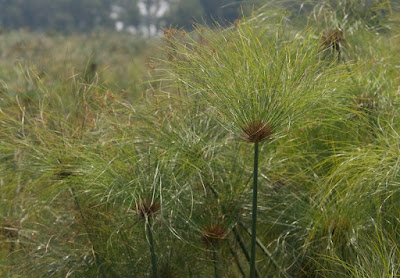


















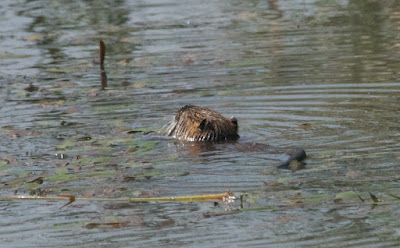



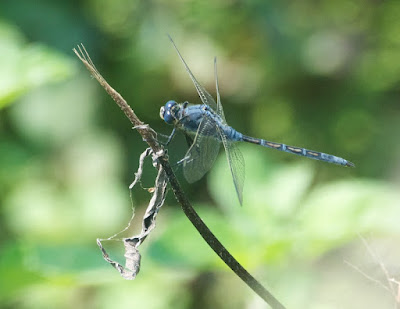



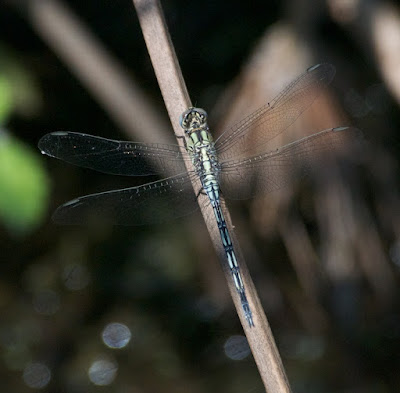



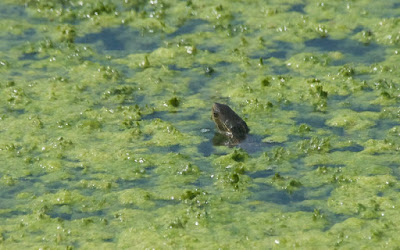

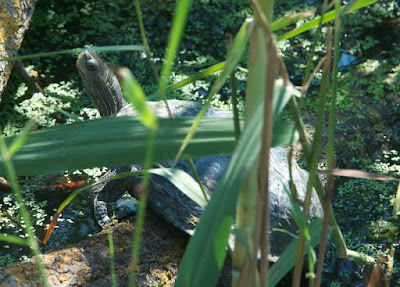
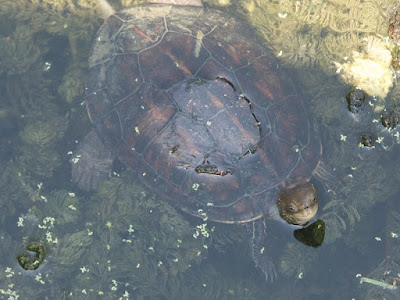





 .
.






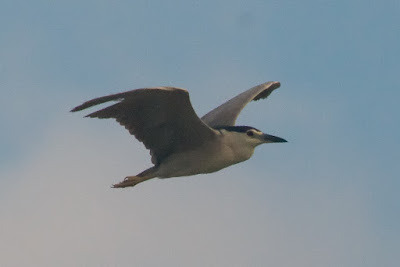

No comments:
Post a Comment